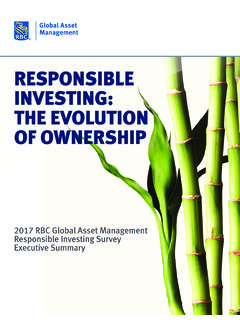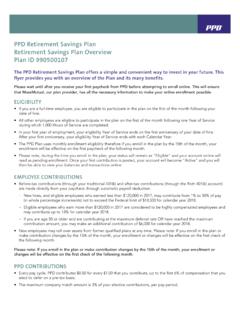Transcription of Private Equity: An Overview - RBC Global Asset …
1 V A N C O U V E RWaterfront Centre20th Floor200 Burrard StreetVancouver, British ColumbiaCanada V6C 3N5C A L G A R YBankers HallWest To werSuite 4430888 - 3rd Street , AlbertaCanada T2P 5C5T OR O N TO155 Wellington St. West22nd FloorToronto, OntarioCanada M5V 3K7 M O N T R E A LTour McGill CollegeSuite 16401501 McGill College AvenueMontreal, QuebecCanada H3A 3M8P r i v a t e E q u i t y : A n O v e r v i e w The Private equity world is in its golden era right now ..the stars are aligned. Henry Kravis, Banking Conference, May 2007 IntroductionThat provocative quote from the head of Kohlberg, Kravis & Roberts, one of the world s largest Private equity firms, smacks of hubris. Yet, given the astonishing growth of Private equity funds in recent years, Mr. Kravis zeal is perhaps justified. Private equity has been around for a long time and has undergone booms before, from the leveraged buyouts (LBOs) of the 1980s to the venture capital frenzy in the late 1990s.
2 But nothing has matched the remarkable growth of the Private equity market in the past five years, with some $ trillion under management globally at the end of The fastest growing sector of Private equity has been buyout funds, which comprised $710 billion of that total, up two and a half times from different this time around is the widespread involvement of institutional investors. Many seem to be hoping to recreate the Yale effect , derived from the success of Yale University and other ivy-league institutions in racking up a succession of huge returns in their endowment funds. One factor in their success was the early adoption of Private equity as a significant part of the alternative investments in their Asset mix. Other pension funds and endowments have followed Yale s lead and, in most cases, this has included an allocation to Private equity . Most have hired Private equity firms, while some, such as the Ontario Teachers Pension Plan, have become active Private equity investors in their own Yale Endowment Annual Report illustrates just how successful that institution has been in the last ten years.
3 Private equity returned annually over ten years, outstripping all of their other Asset classes, most notably those conventional Asset classes of fixed income and domestic/foreign (It is interesting to note that Yale uses the University Inflation Rate +10% as their benchmark for Private equity .) Private equity firms have also been in the headlines because of their fundraising prowess and because of the companies being purchased. In tandem with having more capital, Private equity funds have increased the size of their acquisitions and many of their recent targets have been well-known public companies. Burger King, Neiman-Marcus and Toys R Us are examples of household names swallowed up in recent years by Private equity funds. In Canada, this phenomenon has culminated in the proposal by a consortium led by Ontario Teachers to purchase BCE Inc. for more than C$50 paper considers Private equity from the vantage point of an institutional investor, including a look at the unique aspects of this Asset class, its return and risk characteristics, issues that fiduciaries should consider and, lastly, some interesting recent developments in the broader Private equity realm.
4 Although primarily intended for the Trustees of pension plans or endowments, the paper also provides background information for other types of is Private equity ?By definition, Private equity is capital invested in the direct ownership of businesses that are not traded on public stock exchanges. The three typical structures by which institutional investors access Private equity are:Limited partnership: Private equity investors are typically organized into a pool of funds and legally arranged as limited partners. The pool is operated by a general partner (GP) who charges management fees to the limited partners. The pool of funds has a finite life, during which the GP acquires businesses, (hopefully) increases their value, sells them at a profit and returns the capital to the limited partnership of investors (less the management fees and a share of the profits). A typical Private equity fund has a life of approximately ten years.
5 Fund of funds : In a fund-of-funds structure, investors purchase shares in a number of Private equity funds (similar in principle to the structure of a mutual fund). This allows for greater diversification, and is particularly useful for smaller Alternative Investments in Perspective . RREEF Research. Accessed February 6, 2008. The New Power Brokers: How Oil, Asia, Hedge Funds and Private equity are Shaping Global Capital Markets , McKinsey Global Institute, October 2007. Accessed February 6, 2008. 3 The Yale Endowment Update 2006 . Yale University Investments Office. Accessed October 11 2007. From Ontario Teachers Pension Plan website, accessed March 25, 2008. of FundsLimited PartnerUniverseof PotentialGPsCo-InvestDirectUniverse of Potential Targetsfor Private equity FundingPrivate equity : An Overview 1 Direct investment: With the luxury of size, larger investors can invest directly in a target company, either alone or as a co-investor alongside a Private equity fund.
6 The top ten largest Private equity firms (by amount of assets raised) are shown in Table Notably, three of the top ten firms are located outside of the : As compiled by Private equity International May 2007 The top fifty Private equity firms, in aggregate, have raised an estimated $551 billion in investor capital over the past five years, representing $ trillion in buying power (applying a 5-times leverage multiple). They are also estimated to have paid a remarkable $36 billion in investment fees to Only two Canadian entities rank in the top 50: Teachers Private Capital (Ontario Teachers Pension Plan) at number 20 and Onex Corporation at number invest in Private equity ?The primary motivation to invest in Private equity is to achieve returns above what the traditional Asset classes of public equity (stocks) and debt (bonds) have provided. As the figures in Table 2 show, the longer-term data for Private equity shows returns significantly higher than those of publicly traded stocks.
7 Private equity (to Dec 31, 2006) 1 Yr 3 Yr 5 Yr 10 Yr 15 Yr 20 Yr All Venture All Buyout All Private equity Public equity Indexes S&P 500 Index (US$) S&P/TSX Composite Index (US$)* NASDAQ Composite Index (US$) equity returns are net of underlying fees and expenses. Total return shown for public market indices, except NASDAQ. Source: CVCA - Canada s Venture Capital & Private equity Association, Why Canadian Institutional Investors Should Participate in Global Private equity : Finding the Key Report Implementation (May 1, 2007). Accessed on November 14, 2007. the twenty years to the end of 2006, Private equity has provided excess returns of (annualized) over public equity , as measured by the NASDAQ Composite equity Index (generally regarded as the best comparative benchmark).7 This is a substantial premium and is clearly a prime reason for the increasing interest from institutional investors.
8 Is this premium sustainable? Clearly, returns of this magnitude are now widely expected from this Asset class: to quote a large investment-consulting firm, ..3% represents [a] common industry expectation for the additional return provided by Private equity investments over public equity .8 For Canadian investors, however, it is interesting to note that Private equity has been challenged to beat the commodity-fuelled returns of the S&P/TSX Composite Index, even when measured in dollars. It is only over the 15- and 20-year time frames that Private equity has provided a premium to the annualized returns in the Canadian equity market. Average is an important qualification when discussing the history of Private equity returns. There is considerable cyclicality to the returns, and significant variation among the different categories of Private equity . Note, for example, that the 5-year post- technology bubble returns from venture capital were a nominal It is also useful to note the differences in volatility among the different Private equity sectors, as shown in Table PEI 50: Private equity International s ranking of the world s largest Private equity firms.
9 Private equity International. May 2007. Accessed 27 September 2007. 6 Although public, the NASDAQ Composite equity Index is generally regarded as the best benchmark because of its broader inclusion of mid- and small-sized companies, representing the traditional target market of Private equity funds. 8 EnnisKnupp Capital Markets Modeling Assumptions Updated July 2007 . EnnisKnupp and Associates. July 2007. Accessed 1 November 2007. ASSUMPTIONS-J%e2%80% 9 Alternative Investments in Perspective . RREEF Research. AccessedFebruary 6, 2008. 2 Phillips, Hager & North Investment Management Ten Private equity FirmsLocationAssets Raised Last 5 yrs ($billion)1. The Carlyle GroupWashington Kohlberg Kravis RobertsNew Goldman Sachs Principal Investment AreaNew The Blackstone GroupNew TPGFort Apax Bain Providence equity CVC Capital 1 Table 210 For a summary and detailed explanation of the Sarbanes Oxley Act of 2002 11 Self-dealing refers to the buying and selling assets between funds controlled by the same Private equity firm, with the Asset price set by the general partner, giving rise to concerns over possible conflicts of Alan Rappeport, Moody s Downgrades Private equity .
10 9 July 2007. Accessed September 19, 2007. CVCA - Canada s Venture Capital & Private equity Association, Why Canadian Institutional Investors Should Participate in Global Private equity : Finding the Key Report Implementation (May 1, 2007). Accessed on November 14, 2007. equity : An Overview 3 Source: Deutsche Bank Group, Thomson FinancialVenture capital, which has the highest long-term returns, also has the highest volatility, with a gut-wrenching standard deviation (a broadly used measure of volatility); mezzanine finance, befitting its role as a lender albeit high-risk has much lower volatility; and buyout capital falls in between the two in terms of risk. However, Private equity is a controversial Asset class, and more so in recent years as investors have come to question whether the enormous funds raised of late can continue to provide the premium returns and justify the high fee structures. The key for and against issues are summarized in Table focus allowsExcess leverage artificially boosts returnsAlign objectives of owners & managersSame assets, higher feesStrategic/Operational skills create valueSelf-dealingEndorsed by largest pension plans/endowmentsTop performing firms often closedProponents of Private equity argue that going Private enables corporate managers to focus on long-term results in contrast to the short-term focus reinforced in the public markets by quarterly return releases.






